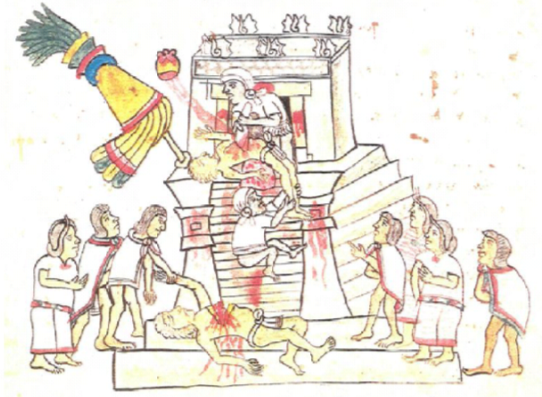Introduction to Mesoamerica
Mesoamerica or better yet, the Aztec empire is described as a very wealthy empire. Tenochtitlan, its capital city is situated within Lake Texcoco and three broad causeways are used to connect it to the surrounding land. Canoes are able to navigate to all parts of the city through the canals. The palace itself is large enough with large rooms and apartments, as well as a fully stocked armory. The markets and the temples in the capital city are the most impressive sights.
The markets are quite large and different kinds of goods are available. The size of the Tlatelolco market for example could be described in the sense that one would take more than two days to walk round the market. In addition, the markets were very orderly. The temples were a place for rituals with regard to human sacrifice. The contrast between the markets and the temples in Tenochtitlan is remarkable since whereas one is experiences peace and orderliness, the other was an epitome of human sacrifice. The two places played a key role in the maintenance of the empire. The markets were a symbol of trade that promoted the functioning f the empire whereas the temples were a place for appeasing the gods and ensure the well-being of this empire (Bentley, Week 1-2).
States and Empires in Mesoamerica
Teotihuacan was initially the largest city in Mesoamerica before the era of war and conquest of the eighth-century C.E that saw the decline of the city. Subsequently, countryside and northern Mexico less-prosperous but well-organized forces targeted the already declined capital city. A lengthy era of militarization and empire-building began with the attacks on Teotihuacan. The process of empire building lasted until the Spanish gained entry and power over the region during the 16th century.
The Toltecs and Mexica
The emergence of both the Toltecs and the Mexica led to the unified rule in Mexico. The Toltecs immigrated into Mexico around the 8th century from the arid land of northwestern Mexico. Their settlement area was Tula, where they tapped water from the nearby Tula River and used the water for irrigation. The Toltecs built a very strong regional empire with the help of their large and powerful army. The Toltecs Empire gained the power to the extent that it was able to transform the capital city of Tula into a rich city through tribute exacted from the royal subjects.
The Toltecs established and maintained good relations with the neighboring societies on the Gulf Coast and the Maya of Yucatan. However, the conflicts that emerged during 1125 C.E. coupled with a nomadic incursion from northwestern Mexico led to the destruction of the Toltec empire in 1175 (Bentley, Week 1-2).
The Mexica, also known as the Aztecs, were among the migrants into central Mexico in the mid-thirteenth century. They were commonly perceived to be trouble-makers by kidnapping women from nearby communities. In addition, they seized land already farmed by others. They were occasionally forced to move after their neighbors got tired forcing them to make the move. As a result, they were continuously migrating due to continued conflicts with other communities. They eventually settled on an island in a marshy region of Lake Texcoco around 1345 and it is here that they built their own capital city of Tenochtitlan, which later was transformed into Mexico City by the Spanish.
The Mexica Society and Religion
The Mexica society was highly hierarchal with the military elite receiving public honors and rewards. Males were deemed to be potential warriors. A majority of the military elite originated from the Mexica aristocracy. The military elite was rewarded with wealth and honors and successful warriors obtained substantial land grants and tribute. Women on the other hand did not have a public role; rather their influence was felt within their families.
However, they were greatly honored as mothers of warriors. The women did not receive any inheritance nor did they hold official positions. They had to be submissive to their fathers and husbands, who were seen as the pillars of the Mexica society. The women evidently played key roles in market places and in crafts.
The Mexica were unique people with unique cultural values and religion before their migration to central Mexico. However, with time, they assimilated other cultural and religious traditions like those shared by all Mesoamerican people. One such cultural practice shared by all people of Mesoamerica was the ball game played informal courts. In addition, they adopted the complicated calendar used based on the solar year of 365 days and a ritual year of 260 days (Bentley, Week 1-2).
The Mexicans also assimilated some of the religious beliefs that were common to the Mesoamericans. The Mesoamericans and now believed in their two principal gods: Tezcatlipoca and Quetzalcoatl. Human sacrifices were offered to these gods for continuity and obtaining favor from these gods. In addition, the priests performed self-sacrifice that entailed piercing their earlobes or penises with cactus. The figure below shows how human sacrifices were carried out (Bentley, Week 1-2).

In this figure, the priest removes a still-beating heart and offers it as a sacrifice to Huitzilopochtli from the victim on the sacrificial altar. The victim at the bottom of the figure is an earlier victim.
References
Bentley. Week 1-2.
Bentley. Week 6.